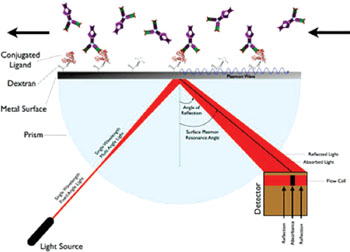Plasmonic Resonance Technique Detects Breast Cancer Marker in Single Cells
By LabMedica International staff writers
Posted on 08 May 2014
A nano-technique based on DNA-tagged gold nanoparticles was used to detect and quantify splice variants of BRCA1 messenger RNA (mMRNA) at the level of single cells.Posted on 08 May 2014
BRCA1 (breast cancer 1, early onset) is a human caretaker gene that produces a protein called breast cancer type 1 susceptibility protein, responsible for repairing DNA. BRCA1 is expressed in the cells of breast and other tissue, where it helps repair damaged DNA or destroy cells if DNA cannot be repaired. If BRCA1 does not function properly, damaged DNA is not repaired, and this increases risks for cancers.

Image: Schema of surface plasmon resonance (Photo courtesy of Wikimedia Commons).
The presence of BRCA1 mRNA splice variants is a marker for the type of gene expression failure that might lead to development of breast cancer, but there is currently a lack of quantitative technologies for monitoring mRNA splice variants in cells.
Investigators at Purdue University (West Lafayette, IN, USA) reported that a combination of plasmonic gold nanoparticle dimer probes and hyperspectral imaging could be used to detect and quantify mRNA splice variants in living cells. The probes were made from gold nanoparticles functionalized with oligonucleotides designed to hybridize to specific BRACA1 mRNA splice variant sequences, forming nanoparticle dimers that exhibited distinct spectral shifts due to plasmonic coupling.
Plasmonic resonance is a phenomenon that occurs when light is reflected off thin metal films, which may be used to measure interaction of biomolecules on the surface. An electron charge density wave arises at the surface of the film when light is reflected at the film under specific conditions. A fraction of the light energy incident at a defined angle can interact with the delocalized electrons in the metal film (plasmon) thus reducing the reflected light intensity. The angle of incidence at which this occurs is influenced by the refractive index close to the backside of the metal film, to which target molecules are immobilized. If ligands in a mobile phase running along a flow cell bind to the surface molecules, the local refractive index changes in proportion to the mass being immobilized. This can be monitored in real time by detecting changes in the intensity of the reflected light. This property allowed the investigators to distinguish between free gold particles and those bound to BRACA1 mRNA.
Results published in the April 20, 2014, online edition of the journal Nature Nanotechnology revealed that a combination of spectroscopy and advanced digital colorimetric image techniques could distinguish between free gold nanoparticles and those bound to strands of mRNA (dimers) and monitor the spatial and temporal distribution of three selected BRCA1 mRNA splice variants at single-copy resolution.
"This is a simple yet sophisticated technique that can be used to detect cancer in a single cell and determine how aggressive it is," said senior author Dr. Joseph Irudayaraj, professor of agricultural and biological sciences at Purdue University. "Being able to quantify these genetic molecules could ultimately help clinicians provide better and more individualized treatment to cancer patients."
"With this method, we are basically able to spot a needle in a haystack - and we can determine if there are 5 needles in that haystack or if there are 50," said Dr. Irudayaraj. "If we can quantify key mRNA at single cell resolution in a tissue biopsy, that will be very powerful in terms of refining treatment protocols for key diseases."
Related Links:
Purdue University







 assay.jpg)





